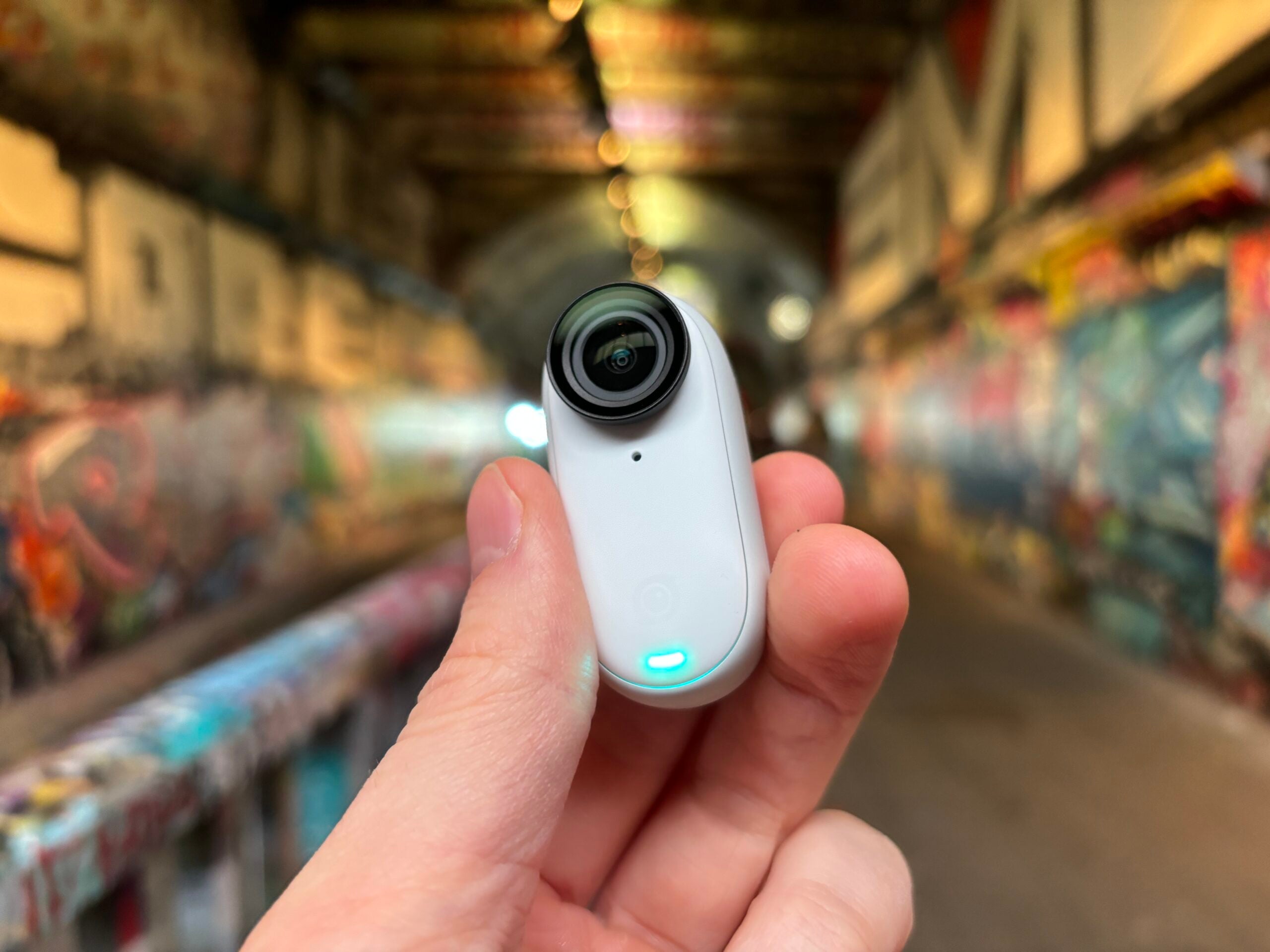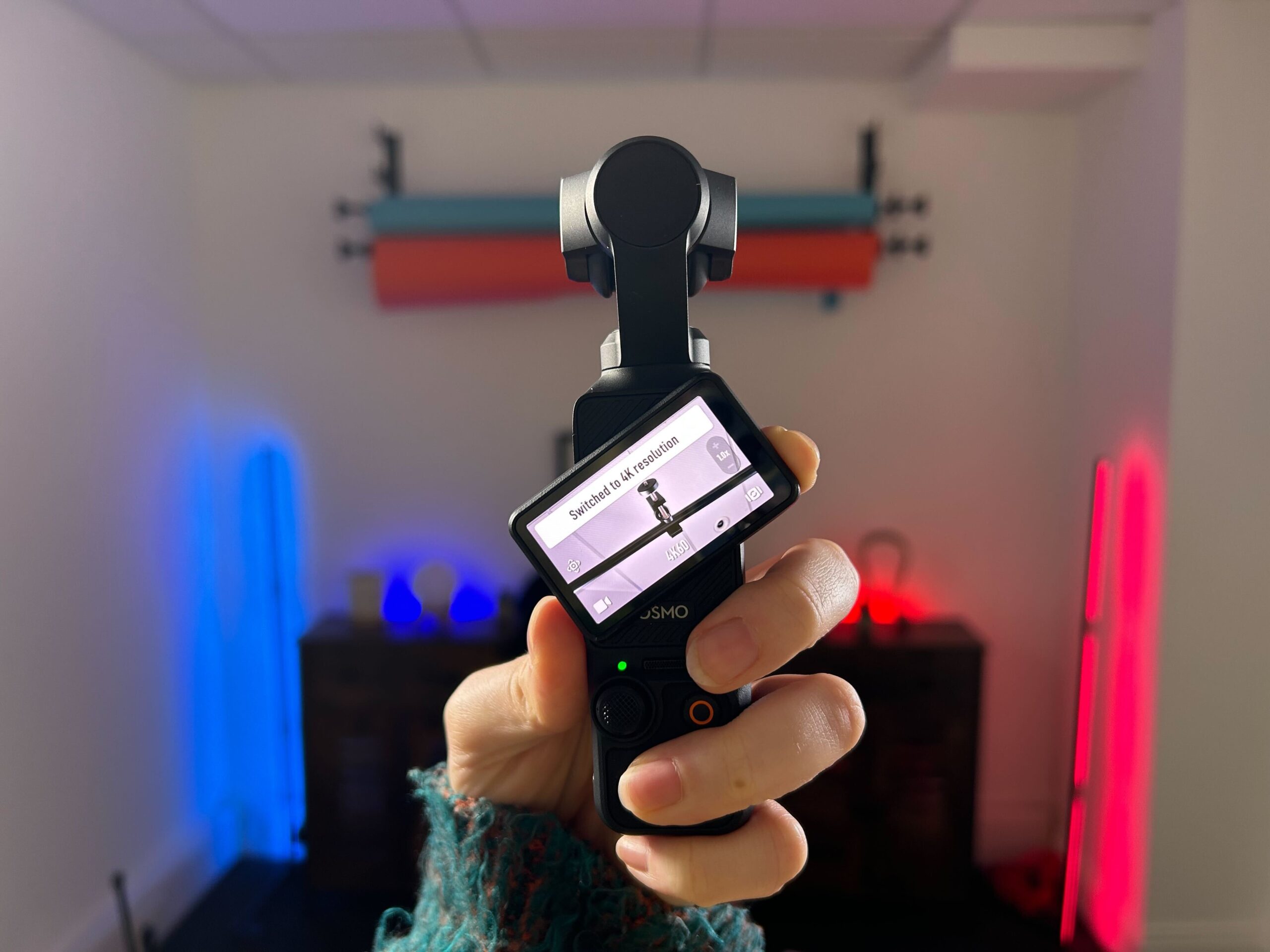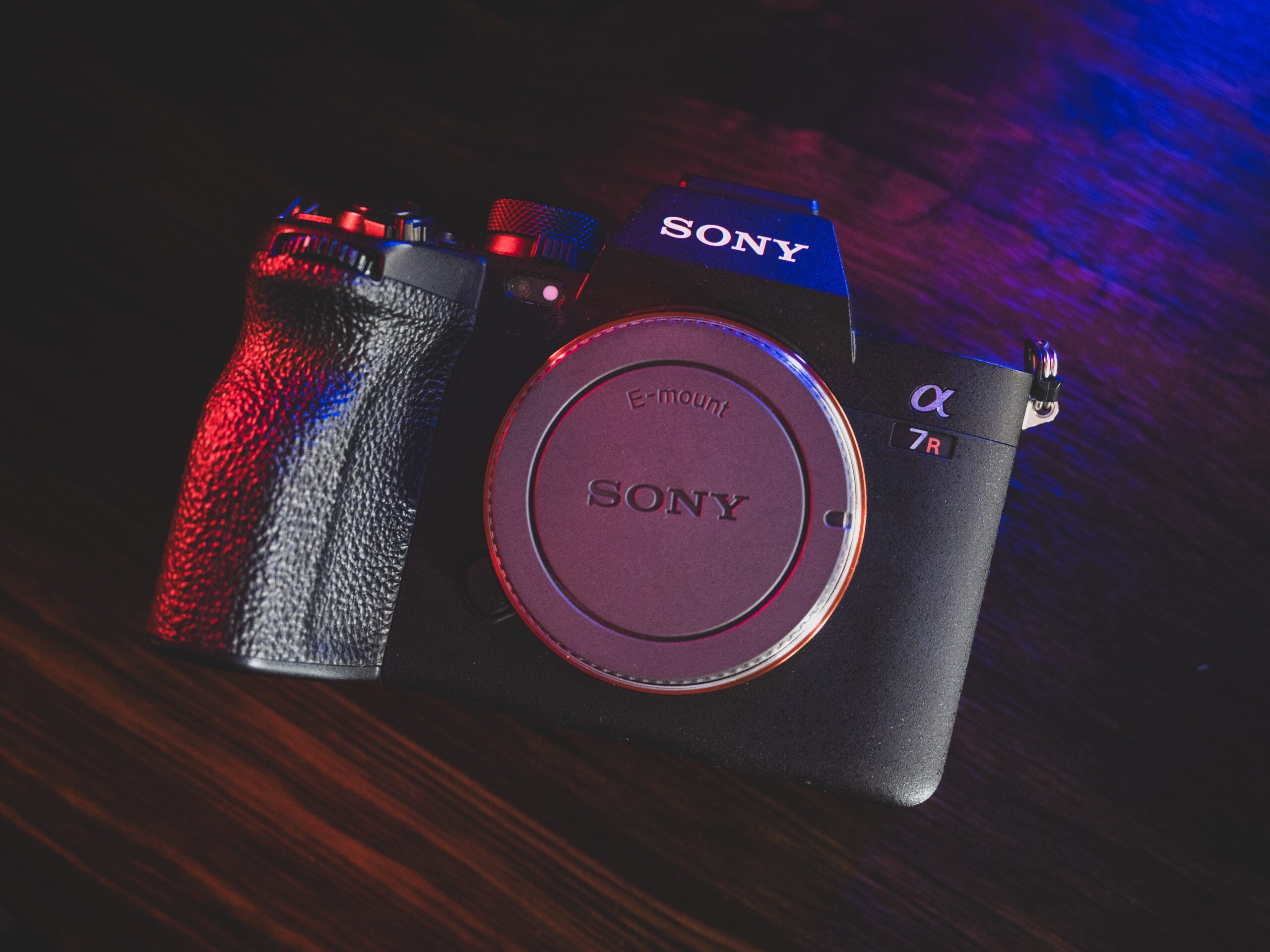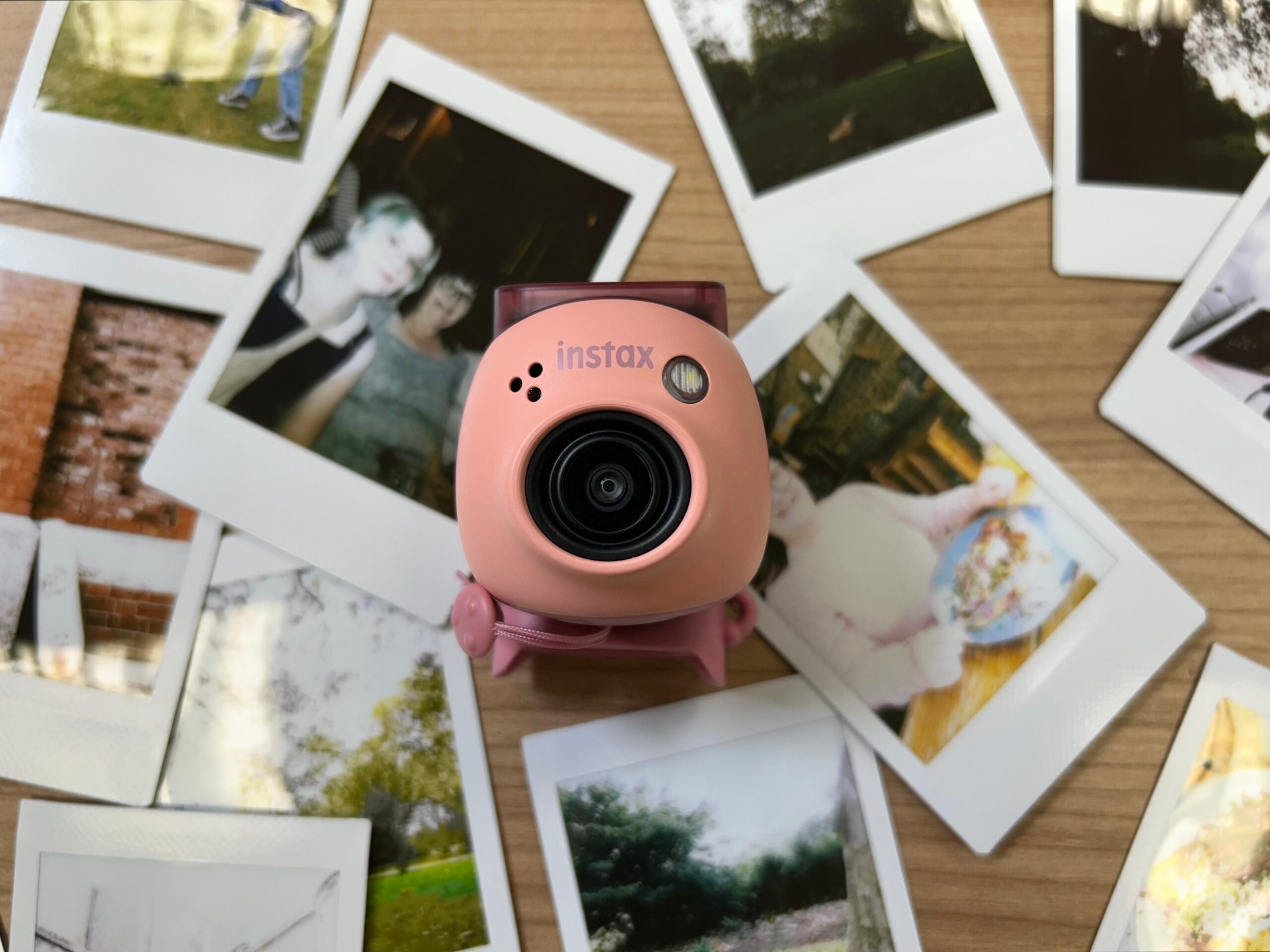Blackmagic Cinema Camera 6K Review
A user-friendly way to shoot cinema-quality video
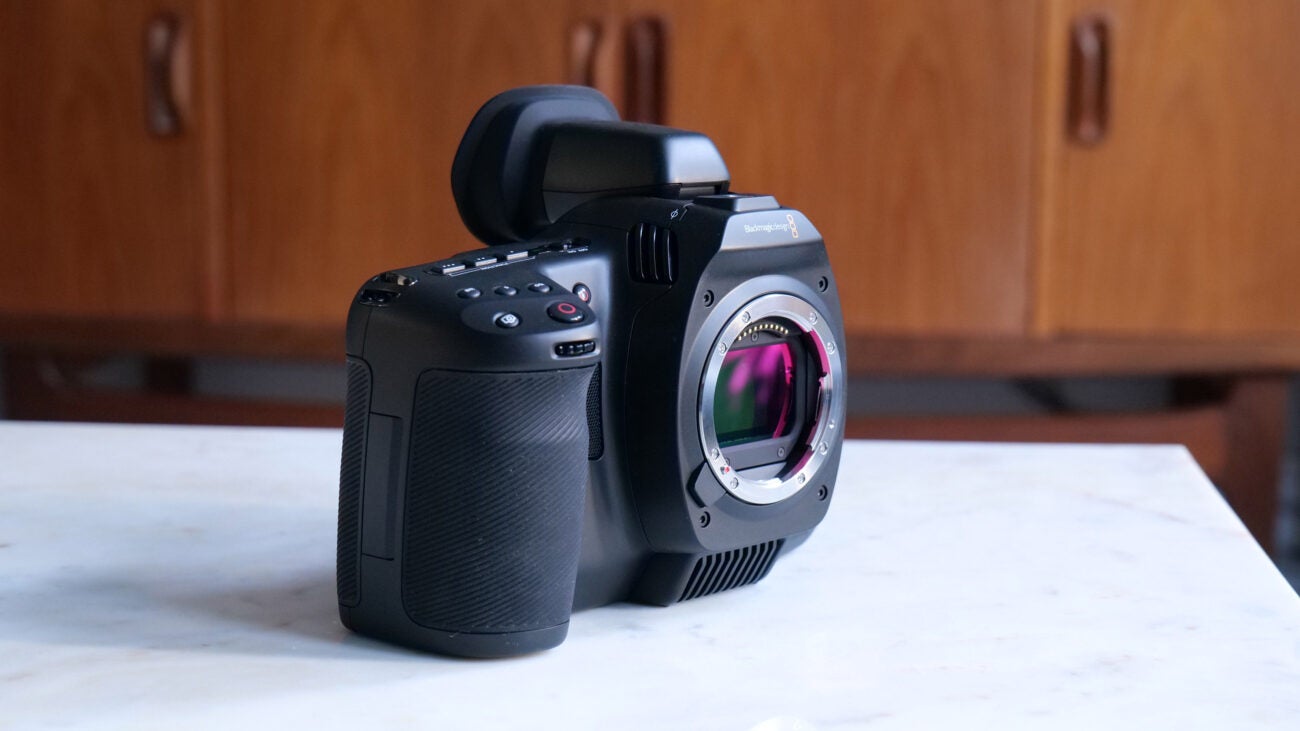





Verdict
The Blackmagic Cinema Camera 6K isn’t a typical mirrorless camera. It’s near useless for still photography and lacks many quality-of-life features. And yet none of that matters, because this camera achieves its main goals by being a lean, affordable and generally user-friendly way to shoot cinema-quality video. Potential buyers should bear in mind that it beats Blackmagic’s existing 6K Pro model in some areas (low light) while falling short of it in others (slow-motion footage).
Pros
- Excellent 6K image quality, especially in low light
- Open gate shooting from a huge full-frame sensor
- Suited to professional filmmaking workflows
Cons
- No IBIS or autofocus tracking included
- Loss of useful built-in ND filter feature
- 120fps slow-mo only available at 1080p
Key Features
- New full-frame sensorFirst 36mm x 24mm 6048 x 4032 sensor on a Blackmagic Cinema Camera
- Shoots 12-bit 6K videoCapture Blackmagic RAW files with up to 13 stops of dynamic range
- Large LCD touchscreenTilting 5-inch capacitive touchscreen with 1920 x 1080 resolution
Introduction
The Blackmagic Cinema Camera 6K is the first new model in the company’s Pocket Cinema Camera range released in over two years, the first to drop ‘Pocket’ from its name and – most importantly – the first to come with a full-frame image sensor.
Previous models have employed 4/3 and APS-C sensors, but the Cinema Camera 6K’s 36mm x 24mm sensor is almost three times larger than the latter, offering filmmakers potential creative advantages in the form of cleaner low light image quality, a shallower depth of field and the ability to use anamorphic lenses without a crop.
The Cinema Camera 6K also features a larger lens mount (the Leica L-Mount) to suit its larger sensor, and is now using CFexpress cards for on-board storage, but in many other ways looks and feels very similar to older Pocket Cinema Camera models.
That might be seen as a good thing, given the range’s reputation for delivering superb quality video in a way that suits professional workflows perfectly – all in a relatively compact and cheap camera body. Let’s find out if this latest model lives up to its predecessors’ high standards.
Design
- Hard plastic body but no weather-sealing
- Four customisable buttons
- 5-inch touchscreen and optional viewfinder
The Blackmagic Cinema Camera 6K is all but identical in looks, size and weight to its Pocket Cinema Camera predecessors; Blackmagic may have dropped “Pocket” from the name this time around, but very little has changed physically. There’s the same DSLR-style shape, same large tilting screen, same front tally lamp and same button layout.
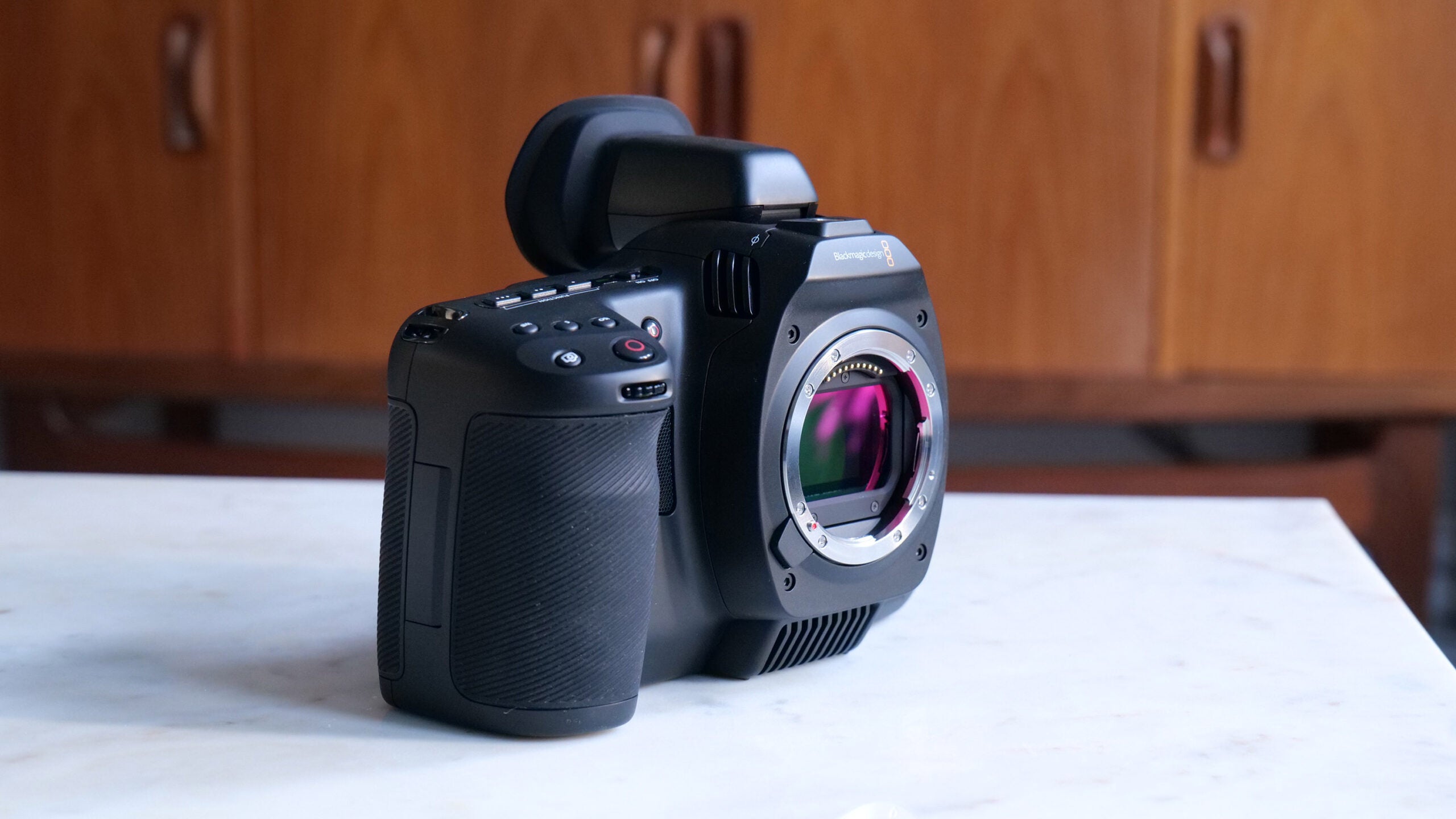
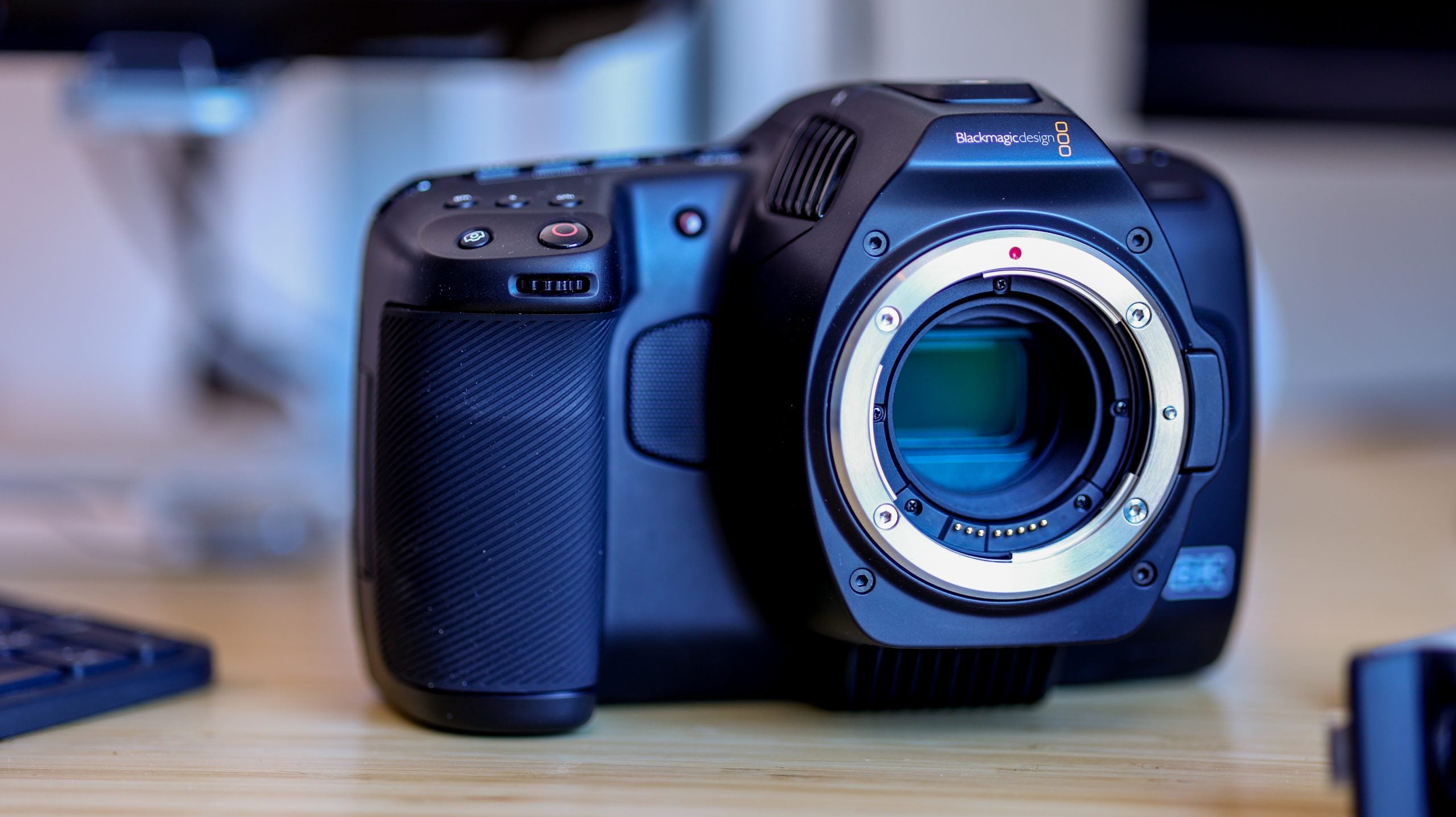
The camera body is constructed from hard polycarbonate (aka plastic) which feels tough enough to withstand long days on set or location, but unlike a lot of premium cameras there’s no weather-sealing here – so use outdoors on a rainy day at your own peril.
It’s a fairly wide, heavy body by mirrorless standards – but a small, lightweight body by cinema camera standards, so I have no complaints about its bulk or dimensions. With a lens attached the thing feels balanced and easy to hold, and the chunky supplied strap helps with portability too.
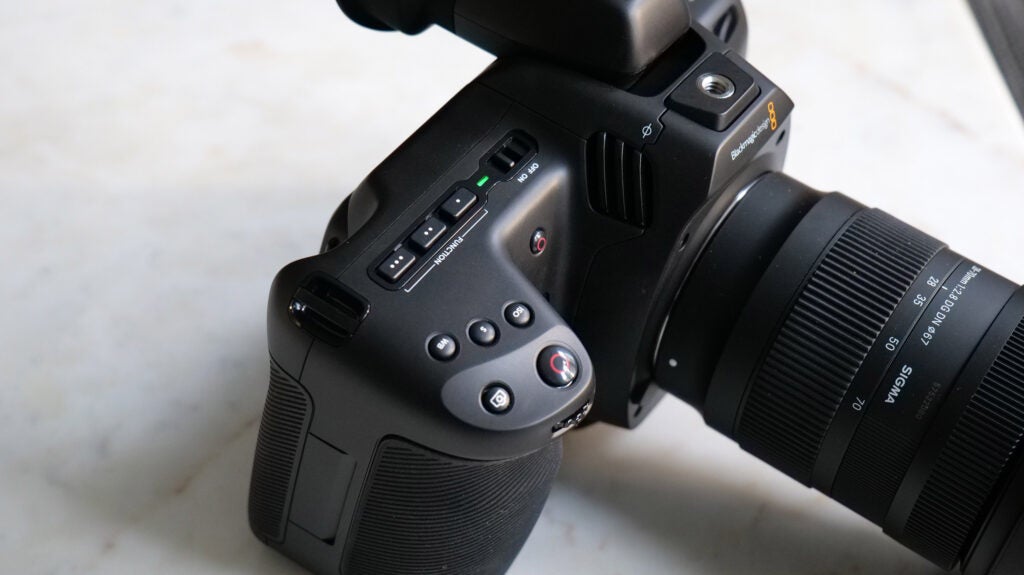
The button and dial layout is solid, with controls well-labelled and located within easy reach of fingers and thumbs. There are four customisable buttons that can be set to control the user’s most needed functions, and the touchscreen interface is simple and easy to navigate.
As on previous Cinema Cameras, the screen is a major highlight. It’s bright (1500 nits), wide (16:9 aspect ratio), sharp (1920 x 1080 resolution) and significantly larger than most mirrorless camera displays at 5 inches across. It can tilt up and down but unfortunately cannot be made to face forward, which makes things a bit trickier for anyone looking to shoot themselves and feels a bit disappointing for a video-centric camera.
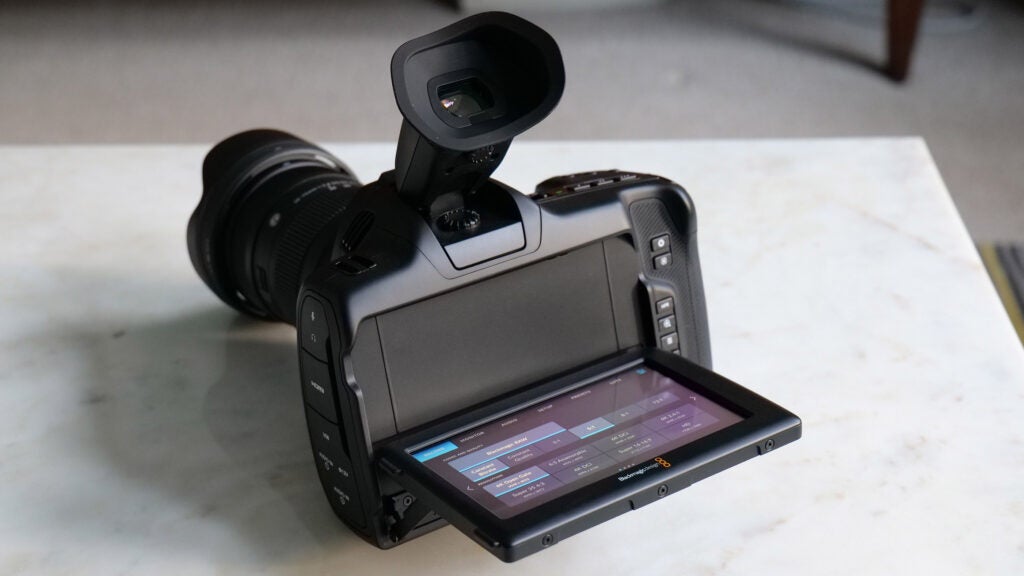
There’s no viewfinder as standard, but Blackmagic’s £485 electronic viewfinder works like a charm should you need one. It’s a fairly expensive upgrade though, so takes a bit of a shine off the camera’s affordability – especially given very few other mirrorless models come without a built-in EVF. In terms of adding other accessories, there are mounting points top and bottom (two here) for the likes of tripods, cages and microphones.
Features and performance
- Built-in gyroscope for post-production image stabilisation
- Single CFexpress card slot
- 2 x XLR and 1 x 3.5mm mic input
Most mirrorless cameras come with some form of tracking autofocus and many offer in-body image stabilisation – but you won’t find either of these things here. Autofocus is included when a compatible lens is attached, but is slow, not always accurate and won’t track a moving subject. Stabilisation can be added in post-production thanks to the built-in gyroscope data, and it’s very effective, but does require cropping your video frame.
The lack of these features doesn’t feel particularly damning here, because the camera is aimed primarily at filmmaking professionals who are happy manually focussing and probably have access to all manner of grips, tripods and gimbals to keep the camera steady while shooting. Still, it’s worth noting that the Cinema Camera 6K is not really a camera for newbies to cut their teeth on – something a bit more versatile and full-featured from one of the major brands would be a much better fit.
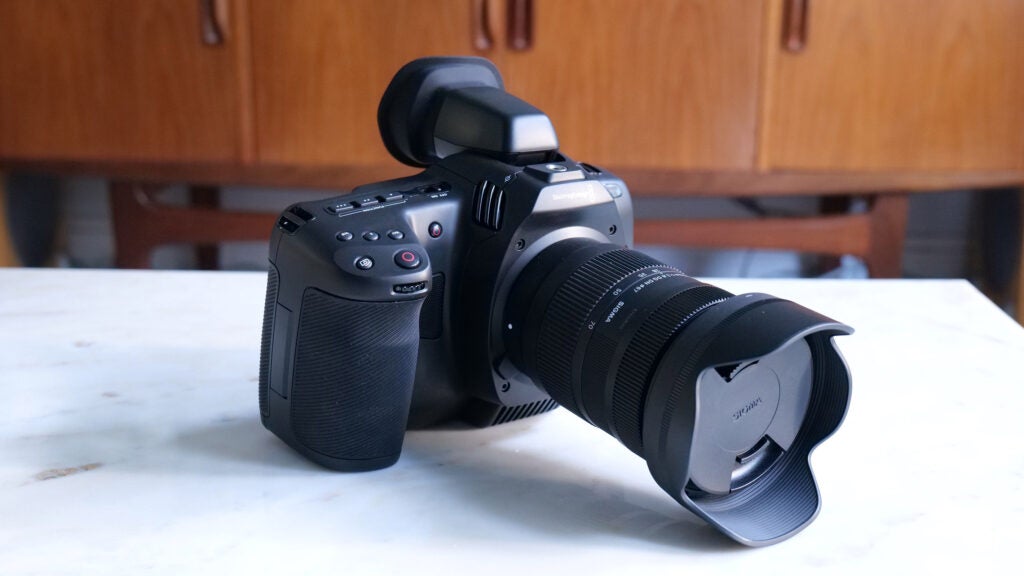
The camera features a CFexpress card slot for on-board storage (a 256GB card can store about an hour of 12-bit RAW footage), and its USB-C port can be used to record to external SSDs and flash drives.
There’s a full-size HDMI output too, but it’s for monitoring rather than recording (supporting a 1080p cleanfeed), while other connectivity includes a 12V DC power input, 3.5mm headphone socket and two types of microphone input: 3.5mm and mini XLR. The latter is rare on a mirrorless camera, but essential for professional filmmaking. There’s also a built-in stereo mic with ports either side of the lens mount.
The USB-C port here isn’t as versatile as on some cameras, as it can’t be used for constant power supply (there’s the 12V for that) or file transfer (users will have to put the CFexpress card in a card reader for that). It can however be used to recharge the battery, albeit only when the camera is turned off. Blackmagic supplies an external charger for this too, and it’s almost certainly faster than using USB.
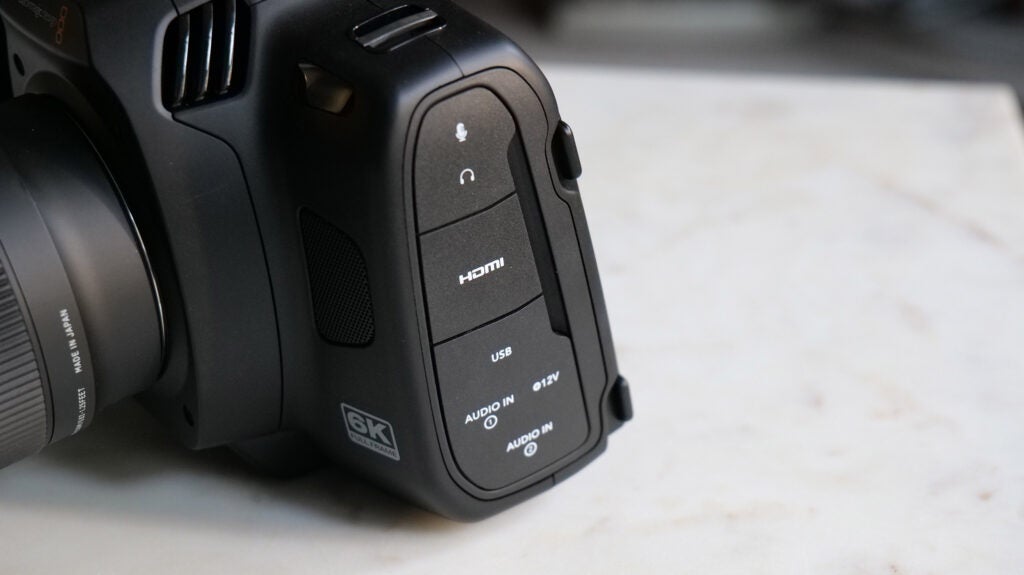
Speaking of the battery, it’s decent. The camera uses large NP-F570 batteries, and a fully charged one gives it around an hour of solid 6K recording. Spares can be snapped up for around £45.
Video
- 6K open gate recording
- 12-bit Blackmagic RAW video codec
- L-Mount lens system
Here’s the main reason to buy the Blackmagic Cinema Camera 6K: like the Pocket Cinema Cameras that came before it, it records excellent broadcast- and movie-quality video at a fraction of the price of many professional video cameras.
What this one does a bit differently to its predecessors is excel in low light situations as a result of its huge full-frame sensor, which offers a dual native ISO up to 25,600. Put a fast lens on it and you can record very usable and relatively noise-free video at night and in other situations where available light is limited.
That’s a definite advantage over the other models in the range, but I was a little disappointed to see that the built-in ND filters from the Pocket Cinema 6K Pro didn’t make it to this camera – which suggests it’s not as suitable for bright sunlight work (at least not without external ND filters added).
It’s also not quite as comfortable recording high frame rate footage as the 6K Pro, which could snaffle up 4K footage at 120fps. Here, you have to drop the resolution to 1080p to achieve that speed.
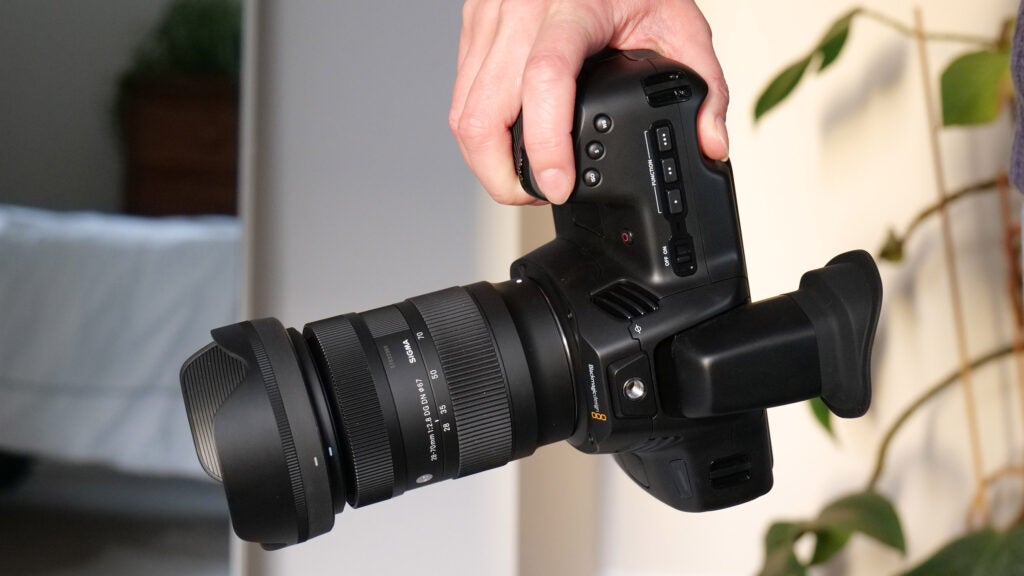
That being said, the Cinema Camera 6K’s full-frame sensor can record “open gate” – in other words, using its entire surface – which is something you don’t get on any other Pocket Cinema Camera. Open gate video is 6048 x 4032, 3:2 ratio and can go up to 36fps, and its big advantage is that you can crop to pretty much any aspect ratio and orientation in post-production.
Also new this time is an L-Mount lens mount, giving the camera access to around 50 native full-frame lenses (made by L-Mount co-founders Leica, Sigma and Panasonic) plus thousands of others via adapters. The L-Mount has been designed with full-frame in mind, so suits the larger sensor of the camera well.
The video quality itself is fantastic. The camera only records in one codec – Blackmagic’s own 12-bit RAW format – but it can be adjusted to various compression levels. Video has a flat look by default but LUTs can be loaded into the camera and applied to give you a preview of the finished look, and in any case you’ll almost certainly be grading and correcting everything in post-production. This is, after all, a camera for pros.
With 13 stops of dynamic range in the 12-bit video files, there’s scope for tons of adjustment in your post-processing platform of choice. I used Blackmagic’s own DaVinci Resolve Studio 18 Studio (a free copy of which comes with every Cinema Camera 6K; regular price is around £260) to edit, stabilise and grade all the footage you see here, and I think it’s a fantastic pro-level piece of software that works brilliantly with this camera.
A final word on stills: you can take them on the camera but the slow autofocus and lack of on-board processing mean photography is a side feature rather than anything like a main attraction. I would honestly rather use a smartphone to take photos than this, but for video few of its rivals can touch it.
Latest deals
Should you buy it?
You want pro-quality low-light footage from a handheld
Blackmagic’s excellent 12-bit codec and the camera’s huge sensor make it suitable for shooting in the trickiest of lighting conditions.
You want a user-friendly hybrid camera
With slow AF, no IBIS and a rudimentary still photography setup, this is a camera with a singular focus: serious filmmaking. It’s not for beginners.
Final Thoughts
Like the Pocket Cinema Cameras that came before it, the Blackmagic Cinema Camera 6K is a specialist tool for a narrow subset of people; it’s not a camera with mass appeal. Big, non-waterproof and lacking many of features you’d expect on a big-name mirrorless camera in this price range, it can be a tricky product to master for anyone not au fait with filmmaking.
But for people who know how to get the best out of it, its capabilities are very impressive, particularly when it comes to low light video capture. It deserves its top spot in Blackmagic’s line-up, even if some of its older brethren might be better at certain things.
How we test
We test every camera we review thoroughly. We use set tests to compare features properly and we use it as our main device over the review period. We’ll always tell you what we find and we never, ever, accept money to review a product.
Tested in a range of different lighting conditions
Video clips were captured in a range of resolution and frame rates
FAQs
You can take photos with the Blackmagic Cinema Camera 4K, but the slow autofocus and lack of on-board processing means you can find better value elsewhere if photography is a priority.
There’s no viewfinder as standard, but Blackmagic’s £485 electronic viewfinder works like a charm should you need one


